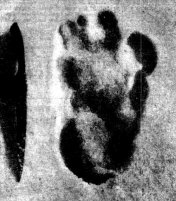
Contact
Yowie / Bigfoot
IS "SNOWMAN" MONKEY?
News (Adelaide, SA)
Date: 8 February, 1951
Page Number: 12

London, Fri.: Tracks in the Mount Everest region of the legendary "Abominable Snowman" are believed by natural history authorities of the British Museum to be those of the langur monkey.
Photographs of huge tracks in the snow taken by Eric Shipton, leader of the Mount Everest reconnaissance party have caused much discussion among European zoologists.
Natives have attributed similar tracks at high altitudes to monstrous origins, but museum authorities say it is probably the langur money, which is brown with a bare black face and silvery head, and is about 5 ft. tall.
It stands on its hind legs, and its feet are nearly 9 in. long.
These facts fit an account by one of the expedition's native porters, who claimed to have seen a "snowman" at 25 yards.
He described it as "half man, half-beast, about 5 ft. tall, covered with reddish brown hair, but with a hairless face."—AAP.
13.07.2015
Bigfoot in the Australian Media (2)

Home

British Museum, London.
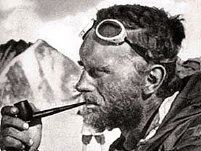
Eric Shipton


Langur Monkey


Mystery snowman
Sunday Mail (Brisbane) (Qld.)
Date: 9 February, 1951
Page Number: 13

WITH Parliament in recess for eight weeks, and Christmas near, the people want to forget the Bevanites and politics, rearmament, and the cold war.
They are only too happy for such diversions as the 'The Abominable Snowman' of the Himalayas, which has been given much prominence here.
This half-man, half-beast, about 5ft. 6in. tall, with reddish brown hair, but a hairless face, becomes a fascinating mystery because the leader of the Himalayan expedition, Mr. Eric Shipton, although he has not personally seen the 'snowmen,' accepts the reports by mountain inhabitants as sincere.
He is shortly to lecture Royal Geographical Society on the matter, and has brought back exciting pictures of their footprints.
The Bevanite Group of MPs came into being following Bevan's resignation from the Cabinet in 1951
over charges in the health service and their relationship with the funding of Britain's involvement in
the Korean War. Bevanites Harold Wilson and John Freeman resigned with Bevan himself. The
group in Parliament drew heavily from the previous 'Keep Left' group, which had previously dissented
from the pro-American foreign policy of the 1945–1951 Labour government.

The Cold War was a state of political and military tension
after World War II between powers in the Western
Bloc (the United States, its NATO allies and others) and
powers in the Eastern Bloc (the Soviet Union and its allies
in the Warsaw Pact).
The first phase of the Cold War began in the first two
years after the end of the Second World War in 1945. The
USSR consolidated its control over the states of the
Eastern Bloc while the United States began a strategy of
global containment to challenge Soviet power, extending
military and financial aid to the countries of Western
Europe (for example, supporting the anti-Communist side
in the Greek Civil War) and creating the NATO alliance.
The Berlin Blockade (1948–49) was the first major crisis
of the Cold War.
With victory of the Communist side in the Chinese Civil
War and the outbreak of the Korean War (1950–53), the
conflict expanded.


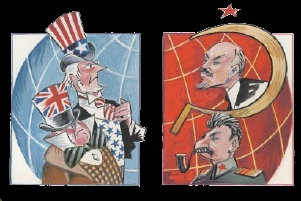
'Abominable Snowman' May Be Only Monkey
The Sunday Herald (Sydney, NSW)
Date: 9 February, 1951
Page Number: 5

STAFF CORRESPONDENT AND A.A.P.
LONDON, Dec. 8.
British Museum authorities believe that tracks of the legendary "abominable snowman" in the Mount Everest region are those of the Langur monkey.
Last week, the leader of a British Everest expedition, Eric Shipton, returned to London with startling photographs of huge footprints in the snow.
He has placed the photographs before the Royal Geographical Society, who helped finance his three-month trip, together with documentary evidence from Tibetans who claim to have seen the creature.
The photographs have caused much discussion among European zoologists.
FACTS TALLY
Despite natives' stories that the "snowman" has supernatural powers, scientists say it is probably the Langur monkey, which is brown, with a bare black face and silvery head.
This monkey is about five feet tall and stands on its hind legs. Its feet measure up to 19 inches.
These facts fit the account by another expedition's native porters, who claimed to have seen the "snowman" at 25 yards range.
They described it as "Half man, half beast, about 5½ feet tall, covered with reddish brown hair, but with a hairless face."
But Shipton, aged 44, who has completed his fifth trip to Everest, says: "I believe we may be on the verge of a great discovery."
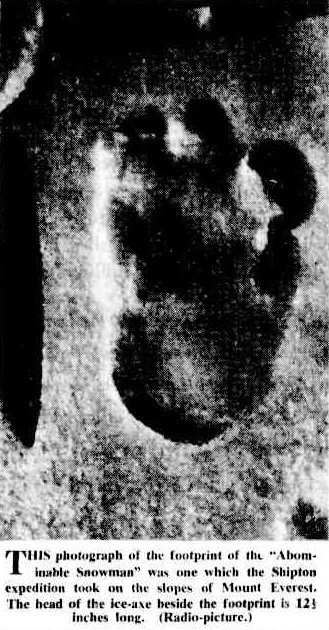
TESTS TO IDENTIFY 'ABOMINABLE SNOWMAN'
The Advertiser (Adelaide, SA)
Date: 11 February, 1951
Page Number: 1

From Out Special Representative
LONDON. Dec. 10.
The trail of the "Abominable Snowman" at the weekend led from the Himalayas to the London Zoo, where British Museum experts watched the feet of a monley and a young bear being dipped alternately into trays of wet sand.
It was a serious, scientific, attempt to solve the old mystery of the Tibetan "Snowman."
The puzzle has been revived again by the publication of photographs of the "Snowman's" footprints taken by Mr. Eric Shlpton, leader of the most recent Mt. Everest expedition.
It began when Mr. Morrison-Scott, keeper of the natural history section of the British Museum, declared that the "Snowman's" prints were really those of the Langur, 'a 4 ft. 6 in. monkey common to South-East Asia.
Challenged by other scientists, he sent an assistant to footprint the Langur and a bear at the London Zoo, so that plaster cast could be made for public exhibition at the British Museum, alongside photographs of the tracks of the "Abominable Snowman."
The Langur footprints were not the same as the Himalayan variety, but experts consider them to be "near enough."
The Langur footprint was 7 in. long, while the "Snowman's" was a foot long.
The bear— "Henry," a two-year-old black Himalayan bear— gave a large footprint.
Commenting on the experiment in the Sunday newspapers, experts are still uncertain whether the answer has been found, although the Langur theory is strongly supported.
The curator of mammals at the Zoo says that the footprints could have been those of a Langur, as the Himalayan variety is a bigger animal than those in captivity.
However, the Zoo, superintendent, Mr. G. S. Cansdale, says a Langur could not have penetrated the crust of the snow, and would have left tail marks.
Leading zoologist Sir John Graham Kerr turns down all the Langur and bear theories, saying that it is an animal unknown to zoologists.
He urges the organisation of a special scientific expedition "to establish the idenity of the 'Abominable Snowman' once and for all."
13.07.2015


Sir Terence Charles
Stuart Morrison-
Scott
DSC DSc FMA
(1908–1991)

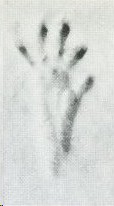
Compare the footprint of a langur monkey (left) to that of the Abominable Snowman (far left). "Near enough"?


Sir John Graham Kerr
FRS (18 September
1869 – 21 April 1957),
was a Scottish
embryologist and
Unionist Member of
Parliament (MP).
Similar report in The Courier-Mail (Brisbane, Qld.) adds: However, the Manchester Guardian says “it is still not clear why
the Langurs should be roaming at such high altitudes.”
The Abominable Snowman
by Rev. Edwin N. Broomhead, M.A., B.D.
The Mail (Adelaide, SA)
Date: 15 February, 1951
Page Number: 10 S

13.07.2015
OUR scientific expedition had reached the summit of Mt. Everest after prodigious hardships.
Among those eternal snows we felt dwarfed
and alone, although we had achieved the object for which we came.
We had to set out to discover why you can't boil eggs at five miles
height.
The answer, as all the world of science now recognises, was—eggs are 4½d. each.
Now, it so happened that while I wandered over
those prodigious peaks, with a pressure cooker in one hand and a scientist in the other—who should I meet but the Abominable Snowman
!
His huge hands hung below his ankles and his vast feet churned the crisp, sharp snow. Fangs protruded from his beard: his little
red eyes twinkled and his big red lips slavered.
Horns grew from his ears and he had a carburettor instead of a nose.
He wore a zoot
suit, a fez, and a Friday charity button.
Haunted hills
"The Abominable Snowman, I presume," I said, with great originality.
"Yah," he
grumbled, "dot is so. Und if you dinks it's fun being a schnowman, you've got der oder dinks goming."
"You astonish me," I gasped.
"A being of your vast power, dwelling among this beauty and in these majestic heights. What could go wrong?"
"Chilblains!" he replied.
He lifted his great foot and turned up the trouser cuff. Sure enough, red, raw chilblains covered it all.
"Positively ghastly, old
boy," I said the Snowman in the best Oxford tone, "Ai get them from the beastly snow."
Then he began to whimper and his little carburettor
fizzed miserably "Ah, sahib," he said (in Hindustani). "Terrible things happen in these haunted hills. Not alone do the chilblains
sore plague me but"—he gazed round in terror—"monsters dwell here! Get ye down ere it be too late!"
"Monsters!" I gasped. "Do you,
then, live in fear, oh Abominable Snowman?"
"Fair dinkum," he answered "Enough to put a bloke off his tucker."
Before I could utter
another word, strange noises came floating across the
snows—the clopping of hooves the jingling of bells and the sound of sleighs.
The snowman screamed in terror and cowered at my feet.
The contagion of fear came upon me and I hid in the pressure cooker.
Then the monster appeared. It was an old chap in red, with a long,
white beard. Reindeers drew his sleigh, which was filled with toys and the music of "Jingle Bells" came over the snow.
"Der Vader Gristmas,"
shrieked the Abominable Snowman. "Caramba! Norn d'un nom ! Senor, she ees a no good."
He burrowed into the hillside until Father Christmas,
with a jolly laugh, had gone.
When all was quiet, the Abominable Snowman emerged, huge, fearsome, and horrible again.
"Now tell me,"
I demanded, as I came out of the pressure cooker "Why do you fear Father Christmas? And why do you speak in all the tongues of men?"
"I
speak in all the tongues of men," he answered, "because I am part of all men—the part that lives in fear of loneliness and the dark."
He
told me many strange things, in many strange tongues, there in the awful silence of the hills.
How he was born of men's fears and nurtured
by their ignorance; now he lived in dark, lonely, and inaccessible places, breeding terror and engendering suspicion.
Many brothers
How
he had many brothers—demonology. necrology, astrology, and the like—all deriving from fear of loneliness and fear of the dark.
How
Father Christmas represents jollity, companionship, and light, and so he fears him.
How science represents truth, sanity, and judgment,
and so he fears it.
How Christ, Who is the Light, the Truth, the Life, and the Way, is most to be feared of all, for in His presence
there is no loneliness, and all the shadows flee away.
I felt somehow sorry for hint, then, for I knew that, for all his long life
and ferocious name, the Abominable Snowman was doomed.
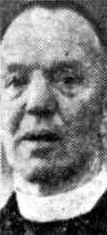
Rev. Edwin N. Broomhead


Zoot suit


Chilblains
SNOWMAN: TRUE or FALSE ? asks "Quidam"
Advocate (Burnie, Tas.)
Date: 15 February, 1951
Page Number: 14

The return of Hymalayan explorer Eric Shipton from the slopes of Everest with photos of an imprint of "The Abominable Snow man" has revived speculation on the exist ence of some, creature unknown to zoologists. Snowmen, apart from the garden variety in winter, are very real to some people.

SINCE time immemorial wherever mountains exist with snow on them stories have circulated about snowmen. In the main, these tales have had no better origin than the imaginative genius of our superstitious forebears.
To-day, we can afford to look back and laugh at the once prevalent beliefs of a god or guardian spirit of the elements.
But in the Hymalayas, for instance, most of the hillmen still accept the god of snow as just one of the many gods in the land. When the first European explorers were told about the "Abominable Snow man" by Nepalese Sherpas (guides) their first reaction was to smile inwardly.
Since then at least three European-led expeditions in Nepal—one German and two English—have encountered huge footprints in the Hymalayan snow at heights of 15,000 feet; footprints larger than human and disturbingly similar in format.
*
ZOOLOGISTS who recently examined the photos of the latest prints taken by Eric Shipton have, if anything, deepened the mystery. They said the footprints were very similar to those of a lemur monkey
.
What this heat-loving tropical specimen of the human family was doing climbing Everest thousands of miles from his favorite Madagascan jungle they could not explain
.
It is significant in itself that any sort of life exists at such desolate ice-bound valleys on the "roof of the world."
Unable to produce tangible evidence on the elusive "Snowman of the Hymalayas, the white men definitely lost a round last week in the eternal (seemingly) fight to down superstition in the Nepalese fastnessness.
Unable to produce tangible evidence on the elusive "Snow man of the Hymalayas, the white men definitely lost a round last week in the eternal (seemingly) fight to down superstition in the Nepalese fastnessness.
The news of the discovery of the footprint in the snow quickly spread through Nepal and portions of Tibet. The event has resulted in round the-clock devil dancing designed to" frighten "The Snow man" 'from the mountain villages should he venture too close.
Of course, there may be a simple explanation. At present it goes abegging.
THE latest "appearance" of the "Abominable Snowman" recalls the story of a Canadian snowman. At first he was in every way as terrifying, then came the explanation.
If you visit Grindstone Island, in the Gulf of the St. Lawrence, not far from Prince Edward Island, recently visited by Princess Elizabeth and the Duke of Edinburgh, inhabitants there will not only give proof of an eight-foot high snowman but will also point out his descendants.
They refer to the appearance of their snowman as the "Miracle of Le Bourdais." It occurred in 1872.
It happened one night when terrific blizzard kept the populace from venturing out of doors, all except a group of boys bored with having to be cooped up in the tiny wooden shacks.
The boys ventured out into the storm to play, only to come face to face with a colossal, frightening figure—a live snow man who shuffled towards them uttering weird noises.
The boys fled. Their parents did not believe them, but they, too, saw the snowman. The fishermen proved no braver than their sons.
*
IT took all the command of the parish priest, Father Boudrealt, to lead a heavily armed posse to investigate. The expedition set out next morning to explore the surrounding area. Near a barn Father Boudrealt (who until then had been very sceptical) also saw "The Thing."
Though seriously troubled, it must be recorded of Father Boudrealt that he approached the figure lying in the snow while his escort fled.
The priest advanced slowly and put his hand out, and touched it. To his intense surprise his fingers merely encountered iced snow.
Then the light of his flare revealed two cavities out of which eyes stared. As he gazed at the snowman it began to "utter the most dreadful moans."
Then the creature managed to murmur "Father! Father!"
The priest sprang up, "Mon Dieu! This is no monster incredible as it may seem it is a living man."
He called the fishermen, who then carried the unfortunate encased in a foot-thick layer of snow to the village. The villagers slowly and painfully removed the snow, but the snowman, Auguste le Bourdais, a shipwrecked mariner, had to have both his limbs amputated.
He survived, however, and in time became a prominent resident in the little community. Parents to-day cannot frighten into obedience the young of Grindstone Island with stories of the frightful snowman.
They know the story too.
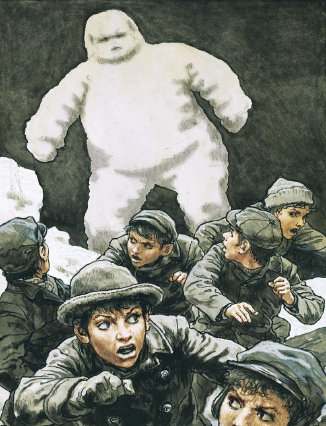
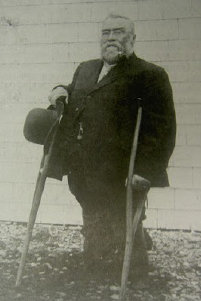
Augustus Lebourdais
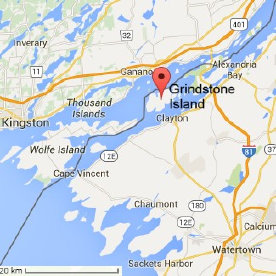
"Quidam" confuses lemurs for langurs >

What is 'Abominable Snowman'?
Sunday Mail (Brisbane) (Qld.)
Date: 17 Dec, 1951
Page Number: 1 & 17


The only way a langur could have left such marks was by leaping across the snowfield, all four of it's feet landing in the same spot. But the tracks were too clear, toes and heel too obvious, to have been made by a leaping monkey. A bear was more likely. There were no claw marks, but Heuvelmans expected as much: bears, he wrote, usually walk so that their claws do not press into the ground. If it was a bear, then Shipton's most famous, clearest photograph showed a hind foot, Heuvelmans deduced from the tracks. What was more, based on the position of the toes, he reasoned that it had to show the right hind foot. Had Smythe been right? Was the Abominable Snowman just a bear?
When he first examined the photograph that Shipton took, Heuvelmans said, he thought that the bear "theory seem[ed] very satisfactory." But he changed his mind. One of Shipton's photographs showed a line of tracks that--according to press reports--had been made by a Yeti. The angle at which the photograph had been taken obscured the details of the prints, but the shape of the gait could be determined--and it was not a trail that could have been left by a bear; the steps were in the wrong place, Heuvelmans concluded. He was right, although for the wrong reason. Almost twenty years later, John Napier, a British anthropologist who did seminal research on primate anatomy, learned that Shipton had taken the photograph of the trail earlier in the day; a goat had left it. The negative had been misfiled, the photograph mislabeled, and the error repeated because the detail was so poor. Heuvelmans did not know of the mistake. He only knew that no animal known to inhabit the Himalayas could have made both the track and the trail--so Shipton had found evidence of an unknown animal. Indeed, combining the {misinterpreted) picture of the trail and the photograph of the print, Heuvelmans concluded that the animal was a biped, a large biped, and that meant some kind of ape... [pg 32-33]


Bernard Heuvelmans (10 October 1916 – 22 August 2001) was a Belgian-French scientist, explorer, researcher, and a writer probably
best known as "the father of cryptozoology". His 1958 book On the Track of Unknown Animals (originally published in French in 1955
as Sur la Piste des Bêtes Ignorées) is often regarded as one of the best and most influential cryptozoological works.


The Advertiser (Adelaide, SA)
Date: 18 Dec, 1951
Page Number: 3

